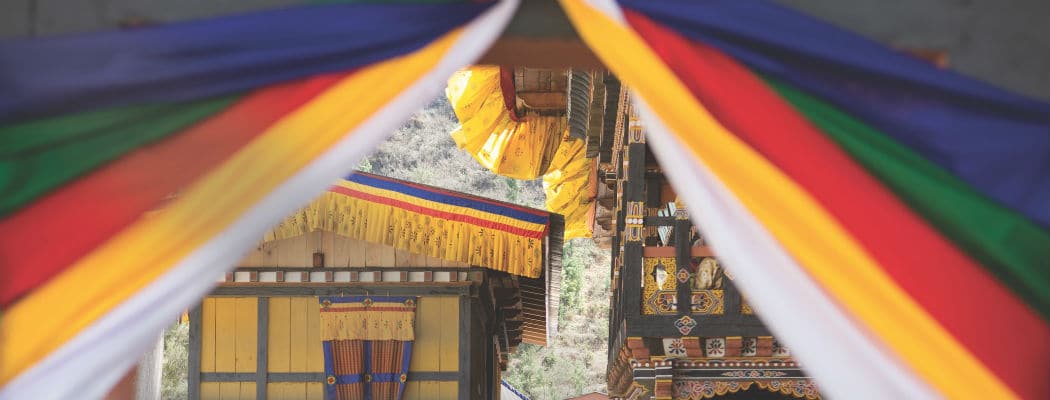World travel, as a cultural phenomenon, has exploded in the 21st century. Lands that were mysterious, difficult to get to, and experienced by just a small number of travelers have now been opened to the masses. Exotic destinations have become a glossy Travel and Leisure checklist from the Congo to the Amazon, the Arctic to the Andes. For an obsessive freelance wanderer such as myself, the indescribable feeling of encountering a pristine environment and unpolluted culture has become a thing of the past. That was until last spring, when I found myself over seven thousand miles away from Nantucket, in the faraway kingdom of Bhutan.
Bhutan was a pleasant surprise and reminder that there are still pockets of travel purity to be found in the modern wired world. This tiny Himalayan kingdom of 900,000 is sandwiched between China and India, and as such acts as a buffer between the two powerful rivals. In many ways it has the feel of Tibet, without Chinese suppression. The predominant religion is Buddhism, and many of the country’s architectural treasures — fortress temples called dzongs — date back to the seventeenth century.
The country is going through a transitional period politically and socially. It has moved from an absolute monarchy to a constitutional monarchy, with many reforms coming from the thirty-three-year-old king Jigme Khesar Namgyel Wangchuck, a graduate of Phillips Academy and Wheaton College in Massachusetts and Oxford University in England. His challenge will be to guide his people on a path to modernization without losing the country’s cultural and religious identity. It was only in 1999 that he opened his country to television and the Internet. In fact, the Nantucket Film Festival will present an outstanding documentary highlighting Bhutan’s tentative adaption of modern-world society in a beautifully shot film entitled Happiness.
Bhutan is one of the leaders in proactive conservation initiatives in the Eastern Himalayas. Written into their constitution is the stipulation that sixty-five percent of the land area must remain forested, with forty percent of its territory set aside as national parks, nature preserves, and biodiversity corridors. This concern for the environment is one of the tenets of their gross national happiness index, a concept that measures the well-being of the citizens. The four pillars of the GNH index are good governance, sustainable socio-economic development, cultural preservation, and environmental conservation. Makes one wonder how Nantucket’s own GNH index would compare.
The country’s two main attractions are its natural environment and its Buddhist culture. Bhutan is not a country one goes to for nightlife or cuisine. It’s difficult to get to, and it is definitely not a backpacker or budget-travel destination. The government imposes a daily tariff of $250 per diem for group tours, and $300 for individuals or couples. However, if you are looking for a place to be active every day, whether exploring temples, national parks, or trekking, the cost is not unreasonable. The per diem covers the cost of a three-star hotel, three meals a day, a private SUV with a driver, and an interpreter guide.
The tourist ministry makes no secret of its intentions to attract a higher economic level of tourist. It looked around at its neighbors Nepal and Sikkim and saw how the cultural degradation took place from rampant tourism, and decided to go its own way. The approach reminds me of the godfather of modern Nantucket tourism, Walter Beinecke. To paraphrase his outlook, “I’d rather see five people with a hundred bucks in their pocket get off the boat, than a hundred people with five.”
The key to enjoying Bhutan is to just get out there, walk the streets, hike the countryside, and trek. Even a one- or two-day trek should be mandatory. There is much in rural Bhutan that hasn’t changed in centuries. Aside from having a driver in a new SUV, here is where your per diem can really pay off. A pack team of four horses, a cook, and a camp organizer are included for most available treks throughout the country.
The Druk Path trek is considered the most popular trek for tourists. It can be completed in four to six days depending on your stamina. Hiking uphill is hard on the lungs, downhill is a test for the knees. There are two passes you climb to, both around twelve thousand feet. The rewards are breathtaking, passing through pine, fir, and dwarf rhododendron forests, mountaintop monasteries, and crystal mountain lakes. On a clear day, you can view the majestic snow-covered peak of 24,000-foot Jomolhari. At lower altitudes, the trees and paths are covered with a primeval type of moss.
Not all treks involve high altitude. One of the most spectacular sights in all of Bhutan, the Tiger’s Nest Monastery (Taktshang Goemba), is located twenty-five minutes outside of Para. A winding trail through pine forests, 1,200 feet above the valley floor, brings you to the holy site festooned with prayer flags and lined with prayer wheels. The structure is magically perched on the edge of a sheer cliff face. On your return descent there is a welcoming teahouse several hundred meters below the Tiger’s Nest. Here you can have lunch and gaze at the Paro Valley below while marveling at the monastery’s precarious location.
In planning a trip to Bhutan, be aware of the seasonal limitations. September to November is the best time for trekking, with warm days, chilly nights, and crystal-clear skies. March to May are generally warmer. Vistas of wildflowers abound, but views come with more fog. Winters are cold and summers are monsoon rainy. That should not pose a problem for Nantucketers, who generally have no time to travel during the hectic summer months anyway. Bhutan is as close as one can get to the Western fantasy of Shangri-La. Nothing seems to be jaded here. There is purity to the air and to the attitude of the people that I haven’t encountered in many other places.





